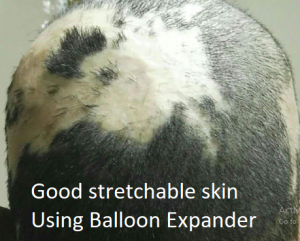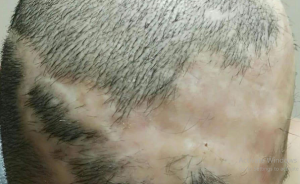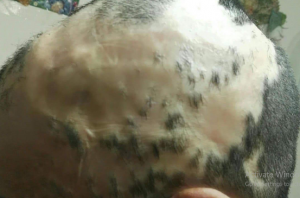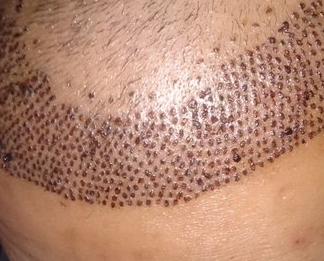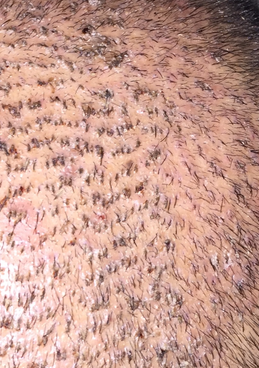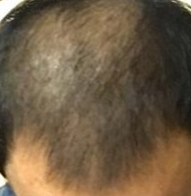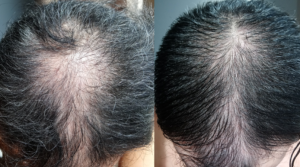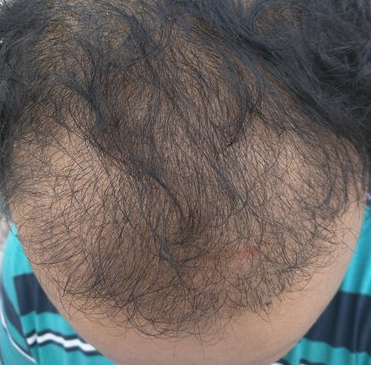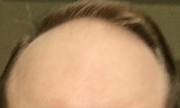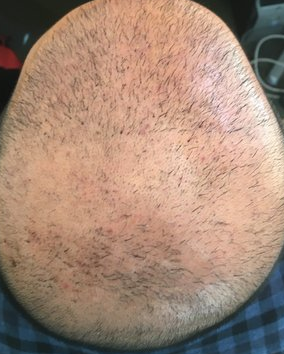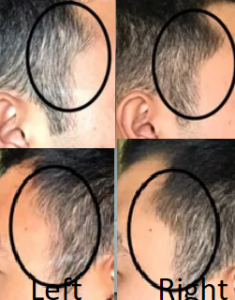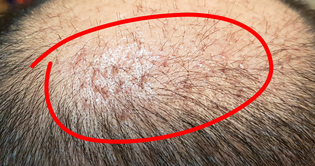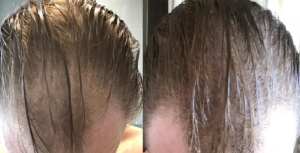These photos show a very extensive burn to the scalp. With the proper skills, reconstruction of this man’s scalp can happen using a combination of Balloon Expanders placed under the good part of the scalp and hair transplants after the maximum amount of expansion is obtained. The patient can use an extensive wig as an alternative if he can’t afford the multiple surgeries or such surgeries are not available in his country. I have seen many people like this transformed with the type of surgery i described above and participated in a few of them.
This is an unfortunate example of a young man who had a hair transplant by a doctor who did not have a sense of either art nor a sense of what constitutes a normal hair transplant. The grafts are all lined up and they appear equal in size. What should have been done is that the grafts should be more randomly placed and the leading edge should have been created with single hair grafts (usually 400 or so) to create a transition zone in front of the hairline so that the patient ends up with a no-hairline hairline instead of a discrete hairline as this unfortunate person will have. This is easy to fix but it requires another small surgery.
We performed a study where we actually picked out the grafts on days 1-15 in over a few dozen patients. The grafts that were removed were sent to pathology. What we learned is that picking the crust (scabs) while they are still there, will pull out the grafts up to 12 days or so. Once the crusts are gone, the living part of the grafts do not come out. The pictures show you still have crusts and are at risk of removing the grafts if you continue to pick on them. Here is the published article for you to read: https://newhair.com/wp-content/uploads/2018/11/mp-2006-graft-anchoring.pdf
Let me address your probe my way. Here is a Class 7 patient who had 11,000 grafts (about 26,000 hairs) in an area that would normally, in a normal person contain 37,000 natural hair follicular units or (possibly 78,000 hairs). It should be clear from the observers, that this man looks like he has a full head of hair, but 75% of his head is transplanted as he and even his father, had a Class 7 pattern of balding: as well as here: https://baldingblog.com/difference-between-norwood-class-7-patients-with-photos/ (the first patient is the father of the previous patient shown here and the second patient had a very fine hair and if you don’t know, fine hair is poor for covering a full Class 7 pattern).
I had 2300 FUE grafts and I am worried about my donor area. Is it over-harvested?
Usually 2,300 grafts will not cause over-harvesting unless your original donor area density was very low and/or your hair is very fine. See the link below that defines the limits of FUE.
https://baldingblog.com/2017/07/21/many-fue-grafts-many-fues-grafts-one-know-safe-limits/
Several years ago, I was treated for testicular cancer. That included 4 rounds of chemo: Bleomycin, Etoposide, and Cisplatin (BEP). Before chemo, I had a nice, full head of hair. I lost all of my hair during chemo. After the chemo, my hair was drastically changed. It was much, much thinner—especially on the top. After a while, I just started shaving my head. I assumed that there’s nothing I could do about it. I did a little searching and didn’t find anything conclusive
Your chemo may have induced genetic balding. You should be evaluated by a hair expert to quantify if you have a reasonably good donor supply left for a hair transplant. Another good alternative is shown in this post: https://baldingblog.com/smp-on-a-class-7-patient-completed-today-photo/ . This can be made darker but it looks great and it is all a specialized tattoo (https://scalpmicropigmentation.com/gallery/bold-shaved-look/#!). This is a completely headache solution for those with not enough hair for a hair transplant or for those who don’t want a hair transplant.
It doesn’t look like much of it has grown. What should I do now. Should I get PRP and ACell treatments offered by some doctors on the internet?
At seven months, you are seeing less that 50 percent of growth of what you can expect from your transplanted grafts. I would not expect the areas in the center to grow much more. I always tell my patients to go back and speak with their doctor as most reputable doctor will make things right financially. A-Cell and PRP is a waste of your money at this stage.
I‘m from Germany and I suffer from hairloss. I was prescribed fin around 2 years ago. Recently it got worse and I went to a another dermatologist, since I moved places. He told me that he doesnt recommend taking fin and instead take Alfatradiol (apparently it has the same effect as fin but its topical?). Have you heard of this? The product is called Ell-Cranell. I cant seem to find a lot of studies.
Alfatradiol is a weak estrogen and 5-reductase inhibitor medication which is used topically in the treatment of pattern hair loss (androgenic alopecia or pattern baldness) in men and women. You might be better off with topical finasteride plus minoxidil as these are stronger medications.
Page 195 of 1247

